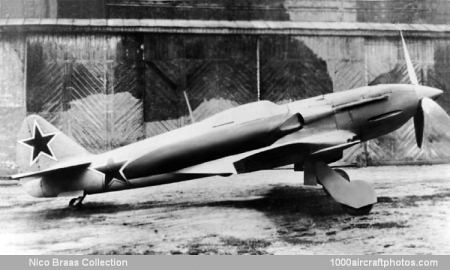Under project manager Anatoliy G. Brunov, the 5A was based on the original type I-220 (aircraft A), even retaining the small tail. The principal differences were a refined and stronger structure, with all-metal outer wings, and a welded pressurized cockpit. The engine was Mikulin's AM-42B with a single TK-300B turbo-supercharger on the right side. Take off power was 2,000 hp, and maximum power at both rated altitude and at full throttle at 24,606 ft (7,500 m) was 1,750 hp. The propeller was the three-blade AV-5A-22V of 11 ft 9.75 in (3.6 m) diameter. The underside of the cowling was deeper than before, but the reduced high-altitude demand meant that the ventral heat exchanger could be much smaller.
Though pressurized, the cockpit had a narrow-frame canopy similar to that of the unpressurized I-220 (aircraft A) and I-221 (aircraft 2A), giving a significantly better field of view. Equipment included improved instruments and controls, and a new radio (described as ultra short-wave, meaning vhf, though served by a wire antenna). Protection included a 2.52 in (64 mm) wind screen and rear glass slab, and 0.35 in (9 mm) seat armor. Armament reverted to four 0.787 in (20 mm) ShVAK cannon, two above the engine and two beside the crankcase, each with 100 rounds.
A single aircraft 5A was ordered, with NKAP (state commissariat for aviation industry) designation I-225. No VVS (air force) designation was allotted, because there was never a serious chance of this aircraft being placed in production. It appeared in two-tone grey camouflage and it was first flown by A.P. Yakimov on July 21, 1944. Trouble must have been conspicuously absent, because only two days later it took off on its fifteenth flight. Unfortunately, on this flight the engine failed at a height of some 49 ft (15 m), and the 5A was damaged beyond repair.
Surprisingly, a second prototype was ordered. This aircraft, 5A No. 02, was fitted with the AM-42FB engine, with a take off and combat power of 2,200 hp. Documents state that pilot field of view was improved. It was put through a fairly brief factory test program, beginning on March 14, 1945. Its level speed proved to be the second-fastest of any Soviet piston-engined (nonjet-assisted) aircraft, beaten only by the much smaller Yak-3/VK-108. It also demonstrated exceptional range, as shown in the data for 5A No. 02:
